Did you know that tomatoes hate cucumbers? Consider companion planting.
While they might taste great together in a salad, tomato plants dislike growing in close proximity to any member of the cucurbit family, which includes cucumbers.
Tomatoes love carrots and basil, however – so planting these together will actually make them each grow more vigorously!
Sounds hokey? The idea that some plants and plant families are “friends” with others and grow better together is called companion planting, and it’s been around since the dawn of food cultivation.
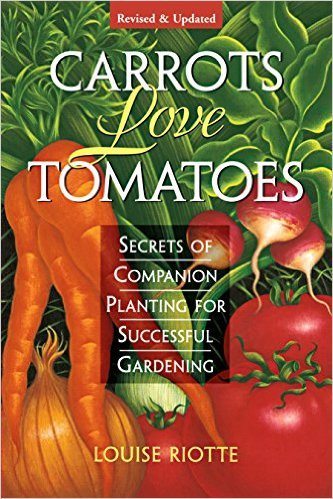
Planting your veggies in neat rows with labels is satisfying to the eye, and easier to harvest. However, when we look to nature, we don’t see rows anywhere, nor do plants all grow clumped up in groups of the same thing together.
Mimicking nature’s biodiversity might make your garden look messy, but it’s been proven to help each plant to grow better. Plants in a polyculture are more resilient and tend to have fewer losses from insects or disease.
Things like carrots, dill, parsley, and parsnip will attract praying mantises, ladybugs, and spiders. These predator species of insects feast on the bugs who like to ruin your tomatoes, so it’s a win-win for the tomatoes (and you)!
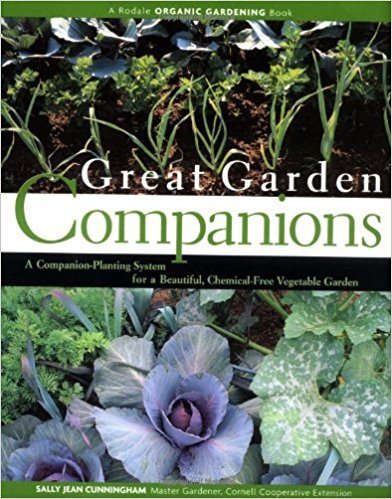
This is also why it’s a great idea to interplant flowers with your vegetable plants–particularly marigolds and nasturtiums. These flowers will attract and feed beneficial pollinator insects, which will increase the fruit-set of many squashes, peas, cucumbers, tomatoes, and other veggies. Nasturtiums are edible flowers and look lovely in salads, and their nutritious root, called mashua, used to be a staple crop in South American regions.
Finally, some plants simply don’t get along, and won’t do well when they’re forced to share root space. Peppers and beans don’t like being next to each other, nor do potatoes and tomatoes (both members of the nightshade family). Peas prefer being far away from onions, and lettuces do not like to be near broccoli plants.
Here’s a great list of plants that grow well together as garden friends. Or, you can grab a copy of the Old Farmer’s Almanac.
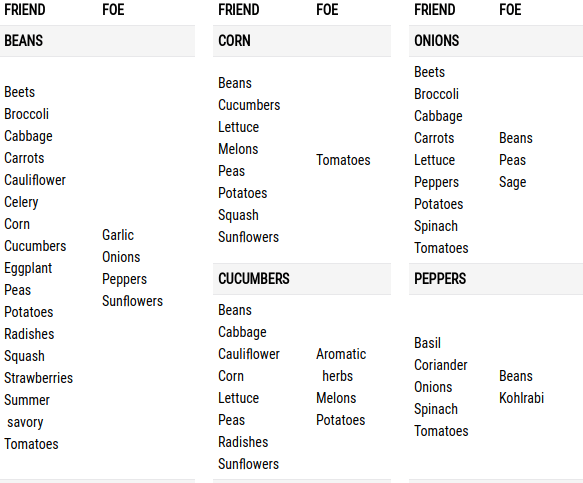
To learn more about companion planting, check out the longtime bestseller, Secrets of Companion Planting, and the more recently published book, Great Garden Companions.
Looking for information on how to grow potatoes? Check this link from The Green Pinky for a guide!
Read More: The Five Most Nutritious Vegetables Varieties For The Home Garden

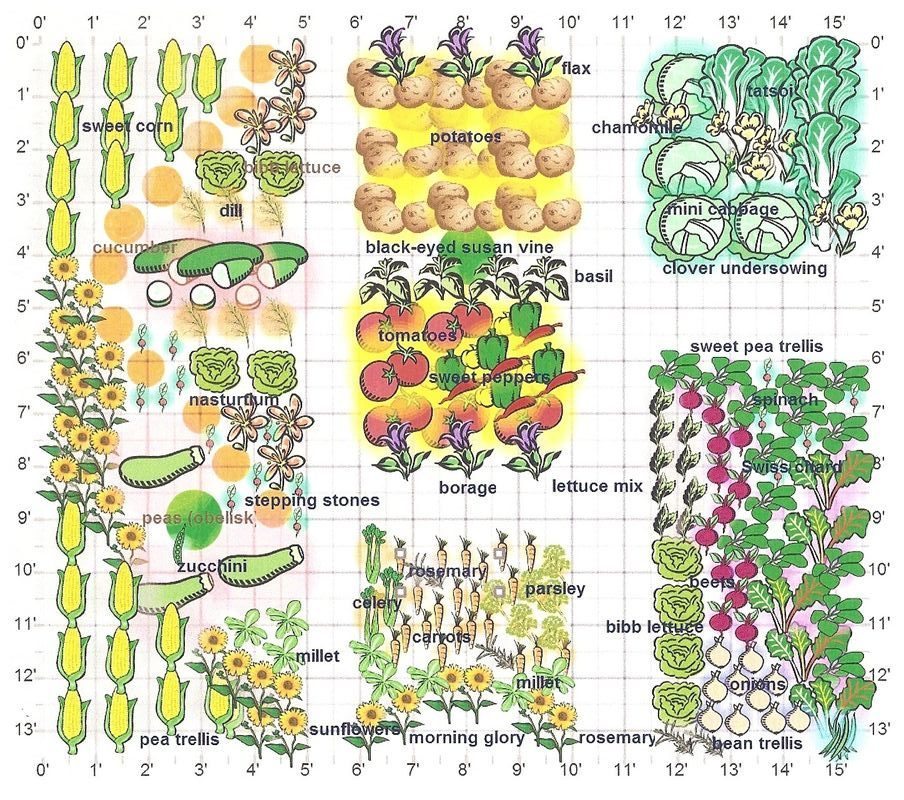
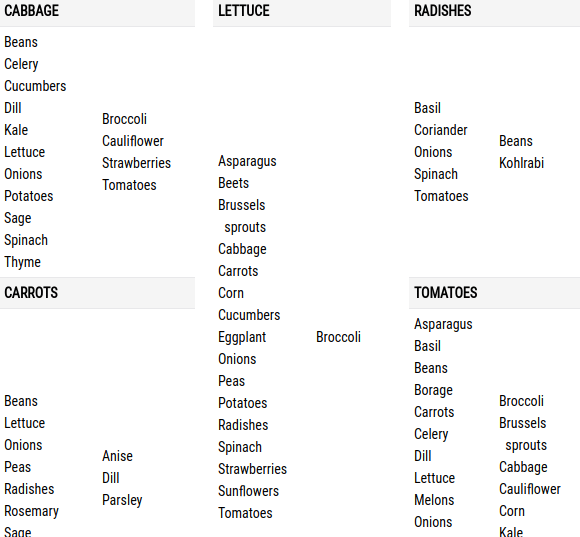



I agree with everything…. except whenever I grow nasturtiums, they are infested with aphids. (wouldn’t eat a one). Do you have any advice for me? This also happens whenever I grow kale. I didn’t have anything friendly planted next to them, though.
I had this issue with kale as well! It was actually so exhausting that I gave up. I will look into this and ask the author if she has any ideas for you!
I had tbe same problem as you. Ants use aphids in the same way that humans use livestock. They actually place aphids on plants. Aphids bear at an incredible pace, sucking on plants and bearing honeydew, a sweet liquid, for ants. The key to growing aphidless kale remains in the timing. Plant kale in a different garden spot than before in the fall! Kale can withstand cold westher! Harvest the kale in the spring. In that way, you avoid the aphid problem!
(also you can just wash aphids off, or spray them off with a hose and soapy water.)
I’ve noticed that one plant gets infected more than the others. I always plant more than I need and throw the most infested ones over the fence where my neighbor’s goats live. By the time the aphids move over, the ladybugs are onto them and clean things up. I think it helps that generations of ladybugs know just where to find the aphids because I’ve never fought them too hard. That probably only works for hobby gardeners though. And I let my kids spray the ant holes with soapy water.
Get ladybugs, they eat a lot of them.
“Along with insects, ladybugs also look for pollen for a food source, so there are numerous plants you can grow to help attract them. Flowers and herbs such as cilantro, dill, fennel, caraway, yarrow, tansy, angelica, scented geraniums, coreopsis and cosmos are good choices for luring the ladybug.”
Never plant Yarrow! I call it dog poop plant: stinky stinky stinky! Buy a skunk first.
i have Red Yarrow! I love Yarrow..Don’t smell, but I love looking at it. Glad to see LAdy Bugs like it too!
Yarrow has medicinal properties, it is beneficial for staunching of blood.
Stanching of blood… by staunch people.
I agree with most of the article. It is true to say that mostly in nature plant don’t grow in rows, but it is not true to say that things don’t grow all clumped together. A lot of the time the same plants do naturally grow in close proximity to one another, probably because seeds drop and germinated, or the plant spreads under the ground. Also, in Australia, and I’m not sure if this happens anywhere else, there are known associations between some plants which are often found together in the wild. But yes, the principal of randomness is also… Read more »
Yarrow is great for insect bites. Rub its leaves on mosquito bites, and the itchiness goes away. With no scratching, the swelling disappears more quickly.
I agree, but not for the smell. You will never be able to get rid of it once planted. It’s like planting creeping charlie or purple deadnettle.
Yarrow is actually a very good medicinal plant. Even more especially for women.
Yarrow is however an excellent medicinal herb. In tea, capsule or tinctured form it can strengthen the spleen and balance blood (blood clotting ) and was used in WWI field kits to stop bleeding. If you have an infection like chronic uti, yarrow for a few weeks will help break the cycle.
My friend tried this. As soon as the ladybugs were released, birds came down & ate them all! So she bought more, and the same thing happened. She gave up, cos she said she didn’t buy them to feed the birds!
Basil also helps
It is best to release the lady bugs at night. They will stay closer to where you release them and the birds are asleep.
Let the ladybugs out at night for sure. Plant friendlies next to the kale. And make a soap wash to spray on the underside of the kale where the aphids stay. Use a Castile soap like Dr. Bronner’s Organic liquid Castile soap. Dilute to instructions on bottle. Works wonders for me with all plants affected by aphids. You have to reapply every week.
always put ladybugs on your plant in the evening this way they don’t fly away and the birds aren’t eating at night.
Wow, I never realized birds may eat them at night!!!!
Ladybugs love to lay thier eggs in evergreens … this year is especially abundant for ladybugs 😆
I had the same issue with tomatoes, i planted a clove of garlic between all the tomato plants, one tomato plant, one clove of garlic, etc.. for each row. The aphids went away in a couple of days and I was also able to grow garlic as a bonus 🙂
Nice trick. Thanks
Next time you have problems with your kale dust your plants with self-rising flour. This trick works well with any soft bodied insect. It kills worms fast and is completely organic.
WOW! Thank you!
Worms are friends to gardeners.
Not the ones that are actually some young moths. Ever heard of the tomato hornworm?
I believe Deborah Pawle is referring to earthworms, Vic. They burrow through the ground, aerating it and adding to its fertility with their droppings. The tomato horn worm is not actually a worm; it is a caterpillar. Don’t mean to start a firestorm; just could not resist.
I believe Deborah Pawle was referring to the earthworm, Vic. They burrow through the earth, aerating the soil and improving the fertility with their droppings. The tomato hornworm is not a worm; it is a caterpillar. I don’t mean to start a firestorm, but could not resisting making a comment.
I always have tomato hornworms. They turn into a huge moth but I can’t off hand think of what they are called. I put some in a jar and watched them. They are ravenous eaters, constantly eating the leaves and I don’t remember how long it takes them to pass but I think it’s about every 10 minutes and out of the other end comes the poop until they get ready to morph.
Worms don’t become moths. Caterpillars do. Common name might be hornworm, but it’s not an actual worm.
The tomato hornworm is a creature from hell! It’ll consume every tomato plant in record time. Then it will pupate into a giant green caterpillar and burrow down into the soul until it hatches into a giant nightmarish moth!
Some worms- but not all-Look it up and see.We’re told to remove grubs and others-so look-(no offense)
Dede…plant Marigolds between your tomato plants and you will never see another Tomato Hornworm. Anytime you see evidence, go out in a very quiet part of the day/nite and listen. You can hear them eating and zero in on them. Feed them to your chickens and they will love you forever 🙂
WOW! This is great advice, thank you!
I’m on a gluten free diet, the flour would make my Kale inedible 🙂
Good call on that! I wonder if gluten free flour would work???
Maybe diatomaceous earth
If it’s self- rising flour that works and not regular flour, then it might be the baking powder in it that is the deterrent. But you’d have to check on that.
Diatomaceous earth is good for a lot of things.
Human grade is real good.
Don’t inhale it
diatomaceous earth is indiscriminate. It will kill beneficial insects. Bees, Lady bugs, praying mantis. You best bet might be (like someone previously stated) release the lady bugs at night, or get praying mantis.
Use diatomacious earth. No glutin and kills bugs fast.
No diatomaceous earth, please. Gardens are a bee haven, and DE is just as deadly to bees as the pest bugs. I do use it, in my chicken coop for chick mites, but not on plants.
WOW! Great info!
DE Kills bees though ?
What about DE on the soil, not the plant itself?
DE kills ALL insects especially bees! It cuts up their exoskeleton and causes them to die. Not a good idea.
Flour doesn’t penetrate. WASH ALL PRODUCE
Just wash it well.
DE diatomaceous earth, has lots of applications but u can use it instead of flour. Side note: stuff is really light so a 10lb bag lasted my small garden two years so far.
OH YES! We have used DE for ants and it works wonders! And fleas!
DE is only effective whe. Just applied dry. As soon as water touches it, it renders it ineffective and you must reapply. I fell for this one. It works if you’re on it but it’s kind of a hassle.
diatomaceous earth (DE)
Was just wondering where to get DE? We having a flea problem in back yard but can’t use lime because I worry about burning the dogs feet. Is mostly grass? Weeds and dirt at the moment but wish to make veggie gardens soon.
TIA
Fi
Are you talking about the food grade or the kind for pools?
Use organic flour…Usually they allergy is due to pesticides which are not found when you buy organic.
All you have to do is wash the kale first to get rid of the flour – it isn’t absorbed into the kale.
just wash the flour off before you eat it.
I was thinking that too!! And here is a little bio lesson for everyone who said “just wash it off”. Would you eat Kale if someone had dusted it with poison and then said “just wash it off”? Are you sure there isn’t any hiding in a leaf somewhere? Gluten is capable of causing intestinal damage at just over 20 parts per MILLION. Not immediate death, but the diarrhea and cramping you get could make you want to die. And for JL…Celiac Disease is an autoimmune disorder, not and allergy or something caused or cured by eating anything organic. ok,… Read more »
Autoimmune diseases come from the poisons we eat in everyday processed foods, like refined white flour. That’s why organic would make a difference. Get rid of the toxins, and Celiac’s holes away.
It is not the ‘flour’ that gets celiacs and those with severe gluten intolerance. It is the gluten in the flour. Gluten is a very sticky substance and not nearly as visible as the flour that it is part of. You will not be able to ‘see’ if you’ve gotten all of the gluten. And for celiacs, it is not worth the risk. My husband has heart damage from being undiagnosed as celiac for far too many years. He also has many different phases of symptoms following an exposure that last up to 9 months. So, no, just washing flour… Read more »
Neem oil. Nontoxic to us but kills everything else you don’t want, including fungus, insects etc.
can’t you just wash the kale off. it’s flour it seems it would just wash off
If you are Celiac you cannot have any gluten IN THE HOUSE – because even when your counters are washed its still there. Truly Gulten free means different bowls, different knives, different counters, different plates – washing is NOT emough. My daughter has been sick for days because of a crumb – one stupid crumb.
Please – if you don’t live with the condition don’t try advising others
Use it to dust the plant. washes off be fore you use it. Still gluten free.
Wow, thanks!!
Mix a couple of drops of dish liquid with water in a squirt bottle and spray your plants, kills aphids on contact and will not hurt your vegetable plants or flowers. I have been doing this for years with success.
My wife knew a lady that allowed her washing machine’s soapy water to drain into her vegetable garden. She said, the lady’s vegetables were much larger than normal size.
Add a couple of drops of dish liquid to a squirt bottle full of water and shake. Spray your veggie and flower plants making sure to get on the back side of leaves also. This mixture kills aphids on contact and does not hurt your plants. I have done this for years with great success. Avoid doing this during the heat of the day.
Try frequently spraying them with soap and water. T
Diatomaceous earth helps with aphids and just about every other kind of bug, totally non toxic-make sure to get food grade,not the stuff for pool filters. Also helps re-mineralize soil.
My trick for crawly bugs–we get japanese beetles and stinkbugs a lot–is the vacuum cleaner. Just get the extension cord and go suck ’em up. Yes, the neighbors thinks I’m nuts, but they thought that anyway.
Neem oil works great to get rid of aphids. It is also organic.
Get some NEEM oil. It’s totally organic and not harmful to humans or other mammals. http://npic.orst.edu/factsheets/neemgen.html
Make a tea out of tobacco or green walnut husk and spray on your plants every couple days and after it rains…ive had great success with both they keep everything but bees away
I feel like I saw a Simpsons episode like this… LOL are you growing tomacco?
I like planting basil with my kale.. from Michigan, never had a problem with nastirums or kale; zuchinni is my issue if I plant from seed I have better luck than from starter plants.
I found that cutting up browning banana peel and putting it under my plants seems to deter aphids!
Coffee grounds are a winner too
It’s good to have a trap crop for aphids, to keep them off other plants. When they get full carefully put a plastic bag around plant and pull it out of ground, while keeping all the bugs in. Tie it tight and put in trash can, never in compost. Kale is a great trap crop too.
Diatomaceous earth works very well on any and all brassicas in my experience. I water the leaves…the only time I do…and sprinkle diatomaceous earth ont he leaves. I try to get as little as possible on the soil.
Mint enhances growth and health and discourages aphids, ants, flea beetles.
False. Mint does *not* deter ants. We have a bed on the south side of our bed, roughly 2’x15′. Filled with nothing but mint and ants.
**Edit** South side of our house lol!
This works on my strawberry plants and nasturtium, two cups of fresh mint chopped, two whole heads of garlic pealed and chopped, two table spoons of chilli powder, blend and bring to boil in 2 litres of water. Then leave mix over night to stand, ( if you can cook and leave out doors to stand because it will also smell out the house!), Drain out the bits and put the liquid in a spray bottle. Stroke the leaves to one side and try to spray the bottom of the leaves!
In my humble opinion, I’d plant them on the other side of the Garden, then plant Marigolds amongst them. Only water the roots, keep air flow between the leaves.
Nasturtiums are detractors which draw aphids away from your other plants. Once covered in aphids you put a bag over them and pull up the plant to burn- aphids and all
If the plant is over- fertilized, it can attract aphids. Nasturtiums don’t need fertilizer.
Soapy water. Cover entire plants. You can buy store bought or make your own. Just make sure the soap is environmentally friendly.
I believe cat mint will help keep aphids away.
https://www.groworganic.com/products/surround-25-lb I love this stuff.
I am trying to get a good view of the image that brought me here. It has Sweet corn in the top left corner and potatoes just to the right, in the top middle… Anyway, where can I see this image? I would love to print it out!
https://www.pinterest.com/pin/45176802486292124/
[…] Read more at thehomestead.guru […]
Neem oil spray is approved for organic gardening and kills aphids.
Mix it with rainwater and use it promptly
Because it loses effectiveness as it ages
what can you plant corn with and squash ??
Beans! The 3 sisters!
My Grandma would plant corn,squash & peas together. The pea vines climb the corn stalks & the squash provides ground cover for the peas & corn. Squash helps to retain moisture for all three.
Never had any problems growing tomatoes close to cucumbers or watermelons, Of course cucumbers and melons need to be fairly far apart from anything including their selves.
Never had any problems growing tomatoes close to cucumbers or watermelons, Of course cucumbers and melons need to be fairly far apart from anything including each other.
Can anyone tell me what to do about brown spots on tomatoes
Did they get cold?
Doterra Peppermint oil diluted in water and then sprayed on the leaves helps eliminate many bugs. If you want more info contact me angiyogabloom@gmail.com or info@yogabloom.ca
We offer doTERRA essential oils here on the homestead guru!http://thehomestead.guru/essential-oils/
That is by far the most expensive remedy to very common and easily managed problem.
[…] Doesn’t seem like there’s any science behind this (at least not in the article), but certain plants might not living next to each other due to allelopathy. Let me know if you have a more sciencey article with these ideas: https://thehomestead.guru/companion-planting-2/?utm_campaign=coschedule […]
The headline/hook of the article is that tomatoes are not companion plants to cucumbers because they are part of the cucurbit family, yet cucumbers are not in the “foe” column adjacent to tomatoes. Additionally, Brussels sprouts, broccoli, cabbage, cauliflower, corn, and kale are not cucurbitae either.
Yes, I too was wondering why tomatoes and cucumber weren’t listed in each other’s “foe” category. Would the author of the article please address this?
I had a problem with gnats in the soil of the plants that I had bought from the store. I didn’t want to throw them out because they were beautiful. I tried everything to cure the problem, and ended up throwing out even my beautiful houseplants that I had raised for years. Does anyone know how to definitely get rid of gnats in the soil.
Use hydrogen peroxide, dish soap and water. The peroxide is actually good for the soul and the soap suffocates the bugs.
How much h2o2 to water and dish soap please! Thanks
I get yellow sticky cards to catch the gnats, and mosquito bits to kill the larvae in the soil. Neither are harmful to the plants, pets or children.
Garlic grown around the roots of roses will deter greenfly
How do l control white flies in tomatoes effectively?
some sort of Inka’s Milpa?
I have a terrible problem with moles (or voles). They destroy everything I plant from the roots up. I also have issues with squirrels. Help!
Holey Moley… Is an OMRI certified mole repellant.
If you put a bird feeder away from your garden they’ll probably go for that instead.
spread coffee grounds around your yard, it doesn’t kill the moles but they will relocate
thorny rose trimmings in the vole holes sends them packing.
Smallspacebigplans: Get a cat, they kill everything. But don’t feed birds where the cat can get to them, as they are good helpers in the garden.
[…] can grow alongside each other. You can also read the Old Farmer’s Almanac to get more information!Sources(function() { var referer="";try{if(referer=document.referrer,"undefined"==typeof […]
Some people like their cucumbers pickled
How do I get rid of the white flakes that seem to fall on my shoulders? Help!
The statement that tomatoes don’t like cucumbers is contradictory to the list given at the end of the article. No where in the list of companion plants does it state that either are a foe of the other. I’m going to try it this summer and see what kind of results I get.
My biggest problems in the garden seem to be squash bugs and Japanese beetles. Is there any way to get rid of squash bugs besides going out and picking them off every day? And the Japanese beetles overrun the garden and decimate the leaves of my plants before they disappear for the season. Any suggestions?
Sow radish seeds around your squash and pumpkin seedlings when you plant them and you shouldn’t have any more problems with squash bugs.
[…] even more than you think you’ll need. Things like tomatoes and peppers can be preserved by canning or pickling. Extra greens, potatoes, and beets can be […]
Companion planting is a great idea. What I like to do also is NOT plant the same thing in a long row, I consider that an invitation to beasties so my garden isn’t neat and orderly, but it sure is beautiful. Have been organic gardening since I was ten years old, that’s 62 years. Still love it!
Interesting, tomatoes hate cucumbers? I have always grown them together with no issues. This year most people in the area had a poor tomato season, I on the other hand had a bumper crop. The tomatoes are finished now however the cucumbers are still producing with the second of 2 planted just getting started (strategically positioned to slow growth). I have never fully paid attention to these so called facts as quite often the reverse seems to occur i.e. no success starting companion plantings. I have tried planting basil near tomatoes and sure they grow but a bit lacklustre. I… Read more »
[…] Homestead guru: Tomatoes Hate Cucumbers: Secrets of Companion Planting […]
[…] asparagus can be planted under trees, tucked between herbs, and so on. We definitely encourage companion planting in the garden AND the general landscape whenever […]
[…] Tomatoes Hate Cucumbers: the Secrets of Companion Planting […]
[…] The secrets of companion planting […]
[…] called companion planting, and it’s been around since the dawn of food cultivation. read more at https://thehomestead.guru/companion-planting-2/ summary via R3publicans Posted in OKG Projects, OKGrassroots Tagged Coddingtons Corner, […]
[…] companion planting, and it’s been around since the dawn of food cultivation. read more at https://thehomestead.guru/companion-planting-2/ summary via R3publicans Posted in Coddingtons Corner, Network, OKGrassroots, Oklahoma, […]
As for an safer way to get rid of pests, my remedies that have worked really well are: lots of marigolds and nasturtiums planted with all my veggies, I plant onions among my tomatoes and peppers, and I spray with a mixture of water, a little bit of soap and red chile sauce. I do also handle my plants pretty often to check for critters (especially tomatoes when I am tying them up and clipping suckers.)
I was thinking of planting Goumi with Pawpaw. Arguments against please.
In my humble opinion, I’d plant them on the other side of the Garden, then plant Marigolds amongst them. Only water the roots, keep air flow between the leaves.
I’ve been reading this list. I have a rose garden and a vegetable garden. I mix a bottle of tabasco with water and spray it in both for bugs. The bugs die and the plants do not. This works especially well for potato bugs. Dawn dish soap and water works for aphids and I have a lot of them in my rose garden. I have asthma so have to watch what I use..cannot use chemicals. I wear a mask when I spray tobasco it can be strong.
Keep the marigolds in pots. Never plant the marigolds in the ground with the edible plants. They will make the food taste like marigolds.
Can you clarify your radish lists. It shows beans are a foe and your bean list says radishes are friend.
[…] More from the Guru: Tomatoes Hate Cucumbers: Secrets of Companion Planting + Popular Planting Combinations […]
[…] tomatoes coming out of your ears, yet? Personally, I (Elizabeth) like to slice them like apples […]
[…] frost date is something that most gardeners view with apprehension, especially when there are green tomatoes on the […]
Well, crap. I’ve been putting my tomatoes and cucumbers together all these years. I need to do some better planning.
Yes! growing tomatoes are easy. However with out any plan, it will be massy.
So the article is called “Tomatoes hate Cucumbers” – they aren’t on each others foe lists…?
Mix 50/50 cinnamon and cayenne pepper and toss it around all plants borders and even safe for on plants. Zero pesticide zero insect pests 🙂
[…] More from the Homestead Guru: Tomatoes Hate Cucumbers: Secret to Companion Planting + Popular Planting Combinations […]
[…] Tomatoes Hate Cucumbers: Secrets of Companion Planting + Popular Planting Combinations • Homestead Guru — Read on thehomestead.guru/companion-planting-2/ […]
[…] More from the Homestead Guru: Tomatoes Hate Cucumbers: Secrets of Companion Planting + Popular Planting Combinations […]
[…] READ MORE FROM THE ORIGINAL STORY AT https://thehomestead.guru/companion-planting-2/?fbclid=IwAR05qOCv3BBuE4sa2BKzQaepcBMDtBzOaEaYUUezr8J… […]
Tomatoes and cucumbers being foes isn’t listed in the chart but it’s the title of the article…??
Any suggestions for Japanese beetles? They destroy my flower garden every year😡 I hate them!
The idea behind growing then alongside food is that they attract aphids, and so detracting them from eating food crops. I get aphids on mine too, so i plant them in a few different places. Usually a planter of them will go unaffected, then I use those for salads etc.
[…] More from the Homestead Guru:Tomatoes Hate Cucumbers: Secrets of Companion Planting + Popular Planting Combinations(Opens in a ne… […]